This Guide thoroughly explores the question What is a Shower Recess, by providing you with all the resources you might need for your important shower recess decisions. I’ll go over the different types or recesses (niches), the pros and cons of each, and some installation issues you should be aware of.
This is Steve from SKG Renovations & Redblock Industries (Steve’s Bio). This actionable info comes from my experience installing all kinds of shower recesses (niches) and shelves during my remodeling career.
Ok, let’s get into it!
Topics:
Recesses (Niches) vs Other Shower Storage
What is a Shower Recess?
A permanent, waterproof, recessed storage space (or niche) with one or more storage levels, built into the wall of your shower for holding soap, shampoo bottles, etc. It’s either framed between the wall studs (custom niche), or installed as a prefab, then finished with tile. Pre-finished units are also available.
Other less popular terms for shower recesses include, built in shower shelves, shower shelf insert, bathtub niche or sometimes even a bathroom niche. Most people consider installing (or constructing) a shower recess because they consider it a better solution than shelves because they are less obtrusive.
What is A Shower Recess – Types:
To fully answer the question, What is a shower recess?, we must first define the two main types:
- Tiled Shampoo Niche
- Finished niche
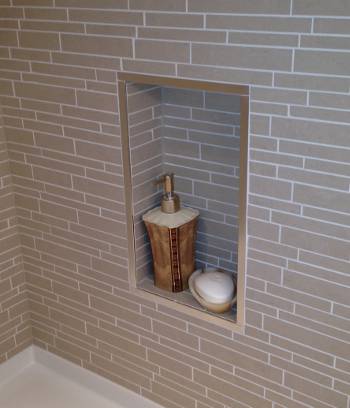
Tiled Shower Shampoo Niche
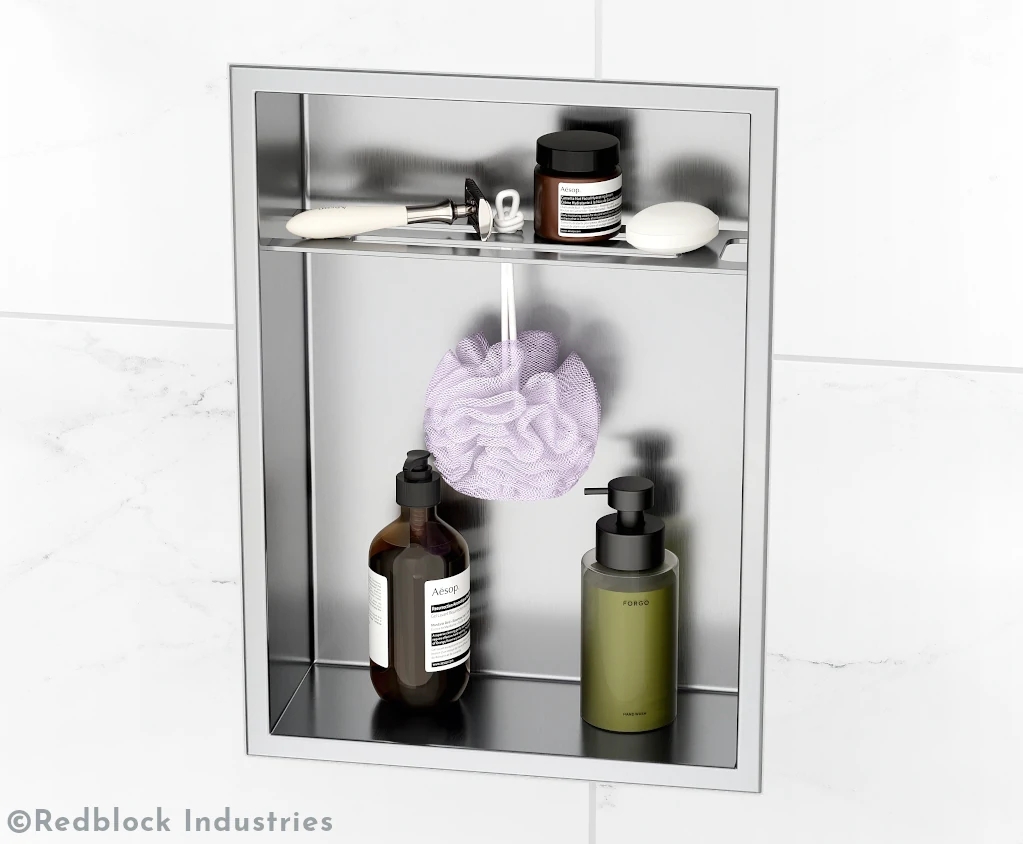
Finished Niche
Tiled Recesses come in three Variations:
i) A Custom Tiled Niche:
- Requires the construction of a framed box between the wall studs, which means that it’s outside width is less than 14 1/2 inches (typical width of stud bay). This also means that this niche stays within it’s chosen stud bay and only extends vertically up the stud bay if more storage is required. The niche box is then covered with tile backer board, waterproofed, then tiled. The main benefit of this type is that it can be built to any custom size (height).
ii) Custom Horizontal Tiled Shower Niche:
- The question “what is a shower recess” wouldn’t be complete without mention of the horizontal niche. This niche requires the construction of a recessed, framed, horizontal box that spans two or more stud bays. This requires cutting away a section of one or more wall studs, so structural reinforcement of the shower wall is required during construction. The interior of the box is then covered with tile backer board, waterproofed, then tiled. This type is the most costly, most time consuming, and most error prone of all the niche types.
iii) Prefab Niche, or Preformed Shower Niche:
- These are the easiest recessed tiling niches to install and waterproof. It can be made of plastic, foam board or stainless steel and it’s surface is designed to be tiled upon (has a tile bonding surface). Most prefabs fully integrate with the shower wall waterproofing membrane via their mounting flange. They are available in only a few standard sizes.
Finished Niches Come in Two Variations:
i) The membrane bonding niche has an outer flange for bonding to the waterproofing membrane and attachment to the framing. They can be made from stainless steel or porcelain. These are much easier (and cheaper) to install than a tiled shower niche.
ii) The retrofit niche mounts into a hole in the finished tile, & fastens to the tile surface with silicone adhesive. They can be made from stainless steel, porcelain or plastic. This type is the easiest to install but DOES NOT bond with the waterproofing membrane so there’s a significant risk of water leaks into the shower wall.
Shower Niche Pros and Cons
To explore the question “What is a shower recess?, it’s helpful to review the pros and cons of each type.
Custom Built Tiled Shower Niche
Pros: The Custom Built Tiled Shower Niche can be built to almost any size, cater to any design scheme, and can be made waterproof. Vertical niches can increase storage with less cost than horizontal niches.
Cons: Risk of water leaks if built poorly and are more costly than other types of shower storage. Horizontal niches are generally the most expensive.
Custom Built Tiled Horizontal Shower Niche
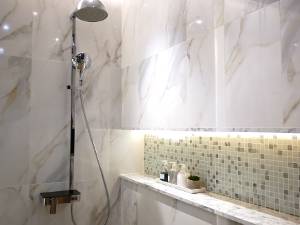
Pros: A custom built tiled horizontal shower niche is a bold statement of luxury with a larger storage capacity than other niche designs.
Cons: The greatest amount of time (and cost) for construction, risks of structural damage during shower wall modification, and only a single recessed shelf for storage.
Tile Ready Preformed Shower Niche Insert
Finished Shower Niche with Membrane Bonding
Pros: This style of shower niche is completely finished so there is no need for tiling, which means easier / cheaper installation, waterproof design, and easy cleaning. It also has a perimeter mounting flange that allows for waterproofing membrane integration.
Cons: Some say the look is too bold (stainless steel types – see image), and some say that the ceramic types are too dated.
Finished Shower Niche without Membrane Bonding
Pros: This type of shower niche is relatively easy to install and has a finished surface, so there is no tiling required.
Cons: Installation requires a full shower remodel (after tiling is complete). It cannot be installed in an existing shower, as some manufacturers claim. It’s also attached to the shower wall with a single bead of silicone and does not integrate with the waterproofing membrane, significantly increasing the chances of a leak.
Niche Install Considerations
Size & Height:
Once you’ve decided on installing some type of recessed storage, then you’ll need to figure out how large, where and how high you want your new niche. Do you want a large shower nook with plenty of storage for a large family, or is aesthetics more of a priority for you?
Where should your niche be positioned? Do you want quick access to products while standing in the water stream, then installation into the valve wall might be appropriate. If you don’t want all your shower items to be constantly drenched with water, maybe installation into opposite wall, or into the long “back” wall might better suite your needs.
And what about height? Are you vertically challenged or perhaps you have kids that will be using the shower regularly? You must pick a height that suites all your needs.
Get more details from my Shower Niche Planning Guide, my Shower Niche Height post or my Shower Niche Sizes post.
Install Problems:
To properly answer the question of “what is a shower recess” we must also go over some of the potential problems of installing one. No matter which shower niche you decide to install or where you install it, there are some important guidelines that must be followed to avoid some BIG Problems like…
No Waterproofing
Many old-school contractors still do not routinely install shower wall waterproofing membranes. As such, leaks at the shower wall corners and the wall to base corner are common with no membrane.
Retrofit Niche Installation
Fitting a retrofit niche into a hole in the shower wall and gluing it to the tile by a tiny silicon bead is always a bad idea. The inevitable result is water in the stud wall leading to water leaks, mold…… you get the idea.
No Membrane Integration
Most finished shower niche products do not have built in flange for attaching to the waterproofing membrane. Whether you buy finished niche or a prefab tile ready niche, you must make sure it is bonded to the membrane.
Compromising Wall Structure
Construction of a custom horizontal tiled niche involves removing a section of the wall studs that support your shower wall. If this procedure is not done correctly by someone qualified, it can seriously compromise the structural integrity of the shower wall.
Outside Wall Installation
It is generally not recommended to mount a shower niche in an outside wall, especially in older homes. You can probably get away with it in a milder climate if the stud wall thickness is 6″ or more but you should check with a local building professional.
Get more details from my 7 BIG Shower Niche Problems post.
Shower Wall Recess vs Other Shower Storage
After the above discussion about “what is a shower recess”, you may have decided that this type of permanent shower storage is not your thing. As such, I thought I would include a short section about other shower storage options and some links to my related post.
Shower Caddy
A popular and cost effective temporary shower storage option is the classic shower caddy. These can take the form of racks suspended between you shower floor and ceiling or be hung from the shower head or shower door.
Caddies can be very effective for many years, but can also fall apart and some can cause damage to your shower floor or ceiling.
Shower Shelves and Racks
Other more permanent but slightly more obtrusive shower storage are the wall mounted soap shelves and shower racks.
These come in a infinite array of styles and sizes in stainless steel, coated steel, wood and plastic varieties.
Floor Racks & Baskets
And slightly more obtrusive again are the floor racks and baskets. These storage options can be more useful because of their larger size and multiple shelves.
The downside is that they tend to take up valuable floor space in the shower and tend to get kicked and tripped over.
Shower Niches
One of the most “permanent” shower storage option is the shower niche, which requires a full remodel of your shower.
A shower niche is fully recessed into the shower wall so it (and all your shower items) stay out of the way during showering.
A very clear downside is the higher cost compared to the other available storage options out there.
See more Hanging Shower Caddy ideas here.
Shower Niche Buying Guide
The discussion of “what is a shower recess” would also not be complete without a cost comparison of all the niches out there.
If you are buying a “finished” shower recess or niche, the costs will be more clear, but what does a tiled shower niche cost to install? Shower niche costs are often not clear to the customer, especially if the bathroom remodel contractor is not breaking down the costs in their quote.
Even a novice can guess that the tiling of a shower wall without interruption is considerably faster and easier than tiling a wall with a shower niche in it. The niche hole involves extra framing (often), as well as meticulous waterproofing and a more complicated tile installation.
I wrote a “Buyer’s Guide” post to outline the costs in more detail, to help the consumer be more informed about their choices.
What is a Shower Recess – Wrap Up
I hope you were able to get some useful advice from my “What is a Shower Recess”post (and the linked content) to help you during your shower remodel project.
If you’d like to write a comment about the array of Shower Niche topics I’ve covered in this post or what topics I may have missed, please let me know in the comments below.
I look forward to hearing from you!
* This post is for information purposes only and should NOT be interpreted as professional advice. You should always consult a licensed local contractor before undertaking any remodeling work in your home. Click here for my full Personal / Professional Disclosure. *
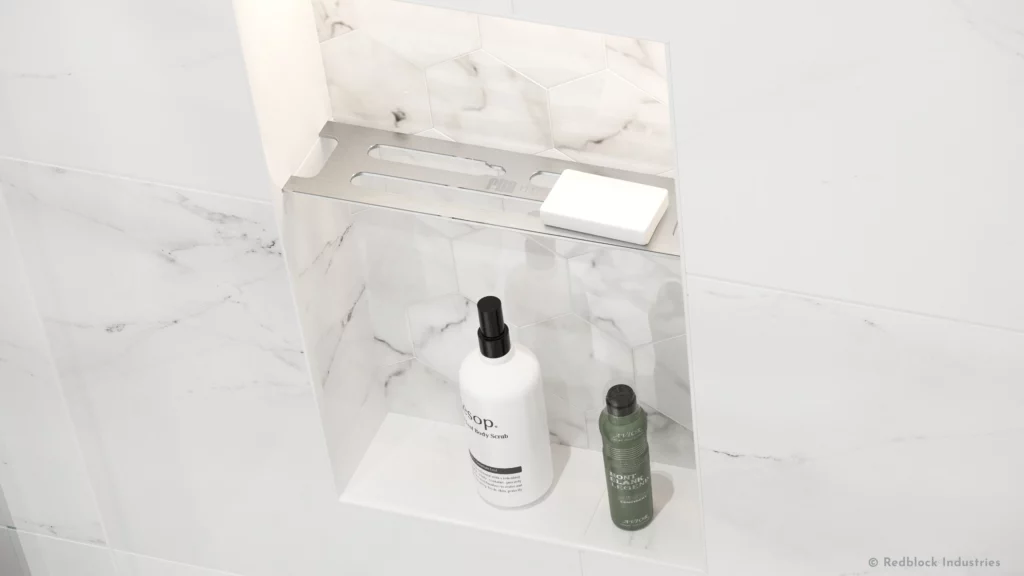

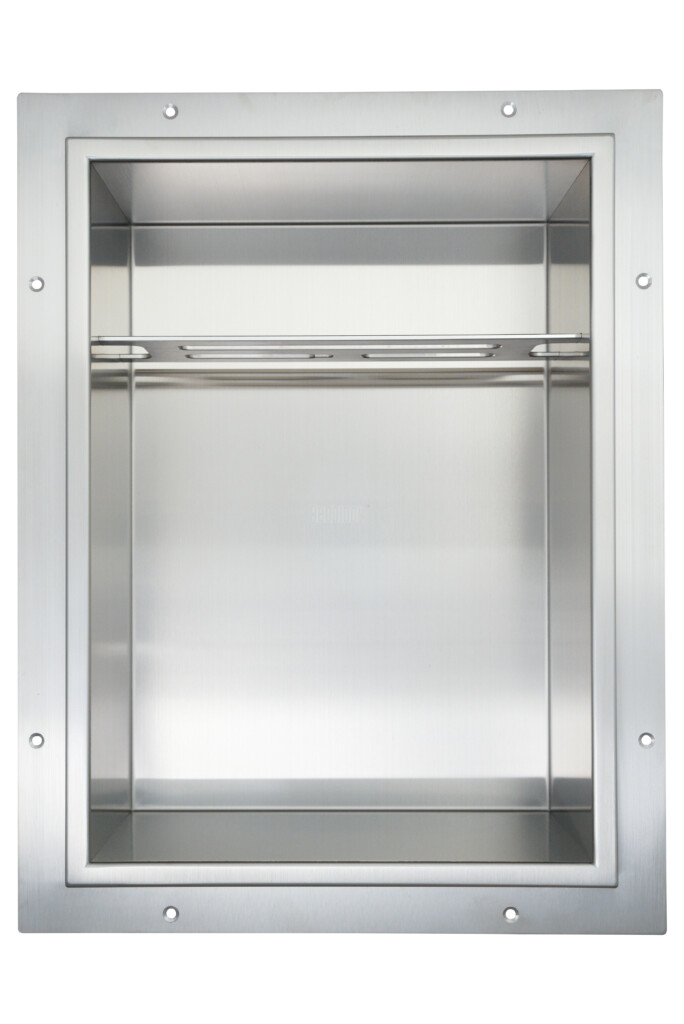

Hi Sarah,
Thank you for your comment!
It sounds like a finished niche with a very thin mounting flange would definitely be appropriate for this situation. Yes, the Redblock Niche is currently out of stock, unfortunately.
I’m sorry, but I’m not aware of any other niche to suggest that has a mounting flange that can be covered without obstruction.
A retrofit niche is always a risk in any shower so unfortunately I cannot condone their installation in good conscience. Sorry about that.
Hard water definitely can have a negative affect on metal fixtures and trims but this is only if scale is allowed to form. It is the wet scale material that can be corrosive if left on metal surfaces. The Redblock niche is constructed with 316 SS, which is one of the most corrosion resistant stainless steel formulations. As such, it can withstand a lot more than regular 304 SS and will stay in good shape as long as it’s kept relatively clean.
Sorry I couldn’t be of more help.
Steve
Plan on using waterproof laminate shower panel system. need to build our interior wall of alcove shower space 2” because panel system is narrower than current fiberglass one piece units. what’s the best way to install shower niche in this situation? Can we use retrofit finished niche in this instance? Would use your stainless units but they are out of stock and we have very hard water and it’s rusting everything even with a softener system installed so would like to use solid surface composite niche if possible.
Hi Joan,
Thank you for your comment!
If the new wall is structured properly (with a strong header assembly), I believe that it’s an OK idea to install a full length horizontal shower niche as long as there’s no shower bench installed on this wall. As I mentioned in my Shower Niche Install Mistakes post, I would always prefer to install a new 3-1/2″ stud wall in front of the back wall to contain the new horizontal shower niche, shower bench or not.
If you are installing a bench on this wall, I would STRONGLY suggest that you install the extra wall. This wall should be firmly attached to the ceiling, floor, and existing shower wall. This will give it the needed rigidity for a shower bench. I would even install some horizontal blocking in the existing wall to further increase rigidity. A bench causes a lot of wall deflection. This is a recipe for disaster (in my opinion), if additional structural measures are not taken to stiffen the entire assembly.
Good luck with your project!
Steve.
Hello Steve,
Thank you for all the information you have provided. I would like to have the contractor install a horizontal niche across the entire back wall. Is there any reason NOT to install such a niche on the same wall where a bench will be built.
I thank you in advance for your response
Hi Rene,
Thank you for your comment!
I’m sorry to say that I don’t believe that there’s a safe way to install a shower niche into an existing tiled shower wall. There are niches out there that can be installed into a “hole” in your tiled shower wall, but I don’t recommend these because they don’t bond with the shower wall waterproofing membrane. These niches are glued to the tile surface with a single bead of silicon, which ends up being your only line of defense against moisture infiltration.
Even if you wanted to install one of these sketchy niches, they’re also not designed to mount into an existing shower wall because it would be very difficult to cut a hole into the wall without damaging the entire assembly.
Sorry for the bad news.
Steve
Hi is it practical or even possible to add a niche to an existing shower wall?
The shower is not damaged and we like the tile job as it is. We are VERY concerned about compromising the integrity of the wall and whatever we find behind the wall. Thank you
Hi Peter,
Thanks for your question.
It’s always best to direct product related questions to our support email (support@redblockindustries.com), but we only sell our product in our web store (redblockindustriescom.temp513.kinsta.cloud/shop). Our business is in Bellingham WA but we have no retail location at the moment.
Steve
I am interested in your product. Can you tell me your company address?
Hi Kat,
Thank you for your comment.
Yes, You should be concerned. Water vapor is likely to condense in the stud wall behind the niche if your contractor installs it in this way.
In general, it’s not a good idea to install the niche in an outside wall because most (or all) of the insulation must be removed to make room for it. Even if it’s mounted in a 2×6 stud wall, there would still not be enough insulation behind it.
Cutting a hole in the vapor barrier plastic (without sealing it against the niche somehow) only makes the situation worse. And there should also be cross framing installed prior to the backer board installation so the niche can be securely attached to the framing all around.
Insulation and vapor barrier plastic is not required for the interior wall. Insulation could optionally be installed in this wall to serve as a sound insulator.
In this situation I would recommend against installing a shower niche in either of these two outside walls. Read this post to find out the only way that I would recommend mounting a niche in an outside shower wall.
Sorry for the bad news 🙁
Steve
Hi there,my shower has 3 walls..the wall with the valve (which is an interior wall) across from that is an exterior wall and the back wall that is in between is also exterior. Contractor suggested niche installation on the wall across from valve wall but it’s (exterior) and now I’m worried. Should I skip a niche altogether? The wonder board has been installed and I didn’t see any cross wood installed between the studs before the wonder board went up. I assume he cuts the wonder board and puts niche inside hole? Would He not then be ripping the plastic that covers the installation? I didn’t think you were supposed to have rips in the plastic. Can he install these cross pieces after the hole is cut? Or was this a step he already missed. I’m nervous things aren’t being done right. My valve wall had no insulation or plastic put in either- contractor says interior walls don’t need it. ???
Comments are closed.